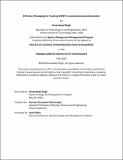Effective Messaging for Tackling NIMBY to Accelerate Decarbonization
Author(s)
Singh, Amandeep
DownloadThesis PDF (916.5Kb)
Advisor
Wainwright, Haruko Murakami
Terms of use
Metadata
Show full item recordAbstract
This study aims to evaluate the efficacy of communication strategies in changing the public perceptions of energy and other facilities that are typically perceived as environmental and health risks. We use the existing US-wide survey data in which the participants were asked about the risks of living near nuclear power plants and which messages were most effective. Our analysis reveals that (1) providing key facts and well- designed messages can change the risk perception, and (2) the messages focused on reassurance (e.g., controlling, containing, monitoring radiations) are more effective than the ones comparing different risks across all the demographic groups. The effectiveness is impacted by demography such that certain demographic groups—Gen Z, the Silent Generation, those with vocational education, and Independents—are more amenable to change, and that the messages focused on social benefits are also effective for the higher education groups and the Democrats. The methodologies offer a framework to improve public perceptions and to create the pathways for the public acceptance of these facilities through identifying key facts and designing messages.
Date issued
2024-05Department
System Design and Management Program.Publisher
Massachusetts Institute of Technology